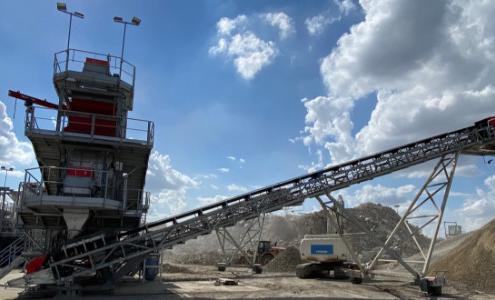The Industrial Dust Challenge
Dust: a simple word that conjures up pictures of disorder and unhygienic conditions, but in the industrial context, it represents a much bigger problem. In many industries, from construction to mining, dust management is not just a matter of order and cleanliness, it’s a necessity to ensure worker health and safety, protect the environment and ensure efficient operations.
Topic Overview: What is Dust Suppression?
At the very heart of dust management lies an essential practice: dust suppression. But what is dust suppression? It’s a set of methods and techniques used to minimize and control the generation and dispersion of dust in various industrial contexts.
Article overview: Exploring Dust Suppression
In this article, we dive deeper into the subject of dust suppression. We’ll start by understanding how it works and why it’s important. Then we’ll explore the different types of dust suppression, focusing on their advantages and disadvantages. We’ll also look at the different industries that use it, while discussing the challenges and problems associated with dust suppression. Finally, we’ll take a look at the innovations and technological advances shaping the future of dust suppression. Follow us on this fascinating exploration of one of the most crucial aspects of industrial management.
II. Understanding Dust Suppression
Definition: What is Dust Suppression?
Dust suppression is a process aimed at controlling, reducing or even eliminating the production and dispersion of dust particles generated by various industrial activities. These particles can be harmful not only to workers’ health and the quality of the surrounding air, but also to the efficiency of machines and production processes.
Why is dust suppression important?
The need for dust suppression in industry cannot be underestimated. First of all, there are health and safety concerns. The inhalation of dust particles can cause a variety of health problems in workers, ranging from temporary respiratory problems to serious chronic illnesses. What’s more, in certain contexts, dust can pose an explosion or fire hazard. Secondly, dust can damage equipment, hinder the smooth running of machinery and, ultimately, reduce operational efficiency. Finally, dust suppression is essential to minimize the environmental impact of industrial operations, contributing to air quality and complying with environmental regulations.
How does dust suppression work?
There are several methods of dust suppression, and the choice of method largely depends on the type of dust, the industry concerned and the specific constraints of the site. However, the basic principle remains the same: to prevent dust particles from becoming airborne.
One of the most common methods is water blasting. Water is sprayed over the area where the dust is generated, capturing the dust particles and causing them to fall to the ground.
Another method involves the use of chemicals or binders that are sprayed or mixed with the dust to agglomerate it and prevent its dispersion.
There are also mechanical methods, such as the use of barriers or covers to prevent the dust from dispersing, or filtration systems that capture the dust before it can spread.
In summary, dust suppression aims to control the dispersion of dust at source, whether by capturing it, agglomerating it or preventing it from moving.
III. The different types of dust suppression
Water-spray culling: A natural method, but not without its challenges
One of the most commonly used methods of dust suppression is water spraying. This technique involves spraying water over the areas where dust is generated, in order to capture the dust particles and cause them to fall to the ground. It’s a natural, simple and economical method, which generally doesn’t require the use of chemicals.
However, there are some disadvantages to water-spraying. For example, water may not be effective enough to control very fine dust particles. What’s more, in regions where water is a precious resource, this method may not be sustainable in the long term.
Chemical culling: An effective solution with environmental concerns
Another popular method of dust suppression is the use of chemicals. These products can be sprayed onto the dust or mixed with it to agglomerate it and prevent its dispersion. This method is often more effective than water spraying, especially for controlling very fine dust particles.
However, chemical blasting can have an environmental impact. Some chemicals can be harmful to the environment if not properly managed. In addition, the use of chemicals can be more expensive than other methods, especially for large operations.
Alternative Dust Suppression Methods: A Range of Solutions for Diverse Needs
There are also plenty of other methods for suppressing dust. For example, some industries use suction and filtration systems to capture dust before it can spread.
Some industries may also employ more specific techniques, such as the use of coatings or binders to agglomerate dust, or the use of innovative technologies, such as mist cannons, which use very fine water droplets to capture dust.
Finally, the choice of dust suppression method will depend on the specifics of each industry, the type of dust generated, and environmental and regulatory constraints.
IV. Applications and Industries using Dust Suppression
Mining Industry: Dust Suppression, a Major Issue
Dust suppression is crucial in the mining industry. Mining activities, such as drilling, blasting, crushing and transporting ores, produce large quantities of dust. This dust can pose risks not only to miners’ health, but also to operational efficiency and the environment.
Dust abatement in mines is often carried out using water sprays, chemicals or ventilation systems. Water spray and chemicals help capture and agglomerate dust particles, while ventilation systems help move and filter the air to reduce dust concentration.
Construction: a sector conquering dust
Dust suppression is also of key importance in the construction industry. Construction activities such as demolition, sawing, drilling and earthmoving generate large quantities of dust. This dust can cause health risks for workers, as well as nuisance for local residents and impact on the environment.
Dust suppression on construction sites is generally achieved by spraying with water, but other methods can also be used, such as the use of chemicals to agglomerate the dust.
Other Industries : Dust Suppression is Everywhere
Dust suppression is not just used in the mining and construction industries. It has applications in a multitude of other industries.
In agriculture, for example, dust suppression is used to control the dust generated by harvesting and transportation activities.
In the metallurgy industry, dust suppression is used to control dust generated during metal processing.
In the food industry, dust suppression is used to control dust generated during food processing, such as grain milling.
In all these industries, dust suppression is essential to ensure worker health and safety, maintain operational efficiency and minimize environmental impact.
V. Challenges and Problems of Dust Suppression
Cost: An investment worthy of the challenge
One of the main challenges associated with dust suppression is cost. Setting up a dust suppression system can represent a significant investment, especially for small and medium-sized businesses. This includes not only the initial cost of the equipment, but also operating and maintenance costs over time. However, it’s important to note that failing to control dust effectively can also result in significant costs, such as medical expenses for workers, regulatory penalties, and even costs associated with production stoppages due to health or safety issues.
Efficiency: a major challenge
Another challenge is the effectiveness of dust suppression systems. Not all dust suppression methods are equally effective in all situations. For example, water spray may not be effective enough to control very fine dust particles. Moreover, the effectiveness of a dust suppression system can vary according to various factors, such as the nature of the dust, the climate, and the specifics of the operating site. It may therefore be necessary to adapt and adjust the system to these factors to ensure optimum efficiency.
Environmental Issues: A Growing Concern
Finally, there are the environmental concerns associated with certain dust suppression methods. For example, the use of chemicals for dust suppression can have an environmental impact if they are not properly managed. Similarly, spraying water for dust suppression can pose problems in areas where water is a precious resource. It is therefore crucial to carefully assess the environmental impact of the chosen dust suppression method, and to implement appropriate environmental management practices.
VI. Innovations and Technological Advances in Dust Suppression
Latest technology: a constant battle against dust
Present-day dust suppression technologies are versatile and adapted to different situations. They include water spraying or atomization, the use of chemicals, air filtration systems and more. These technologies have proved their worth over the years and continue to be widely used in many industries.
However, even with these technologies, dust abatement remains a challenge. That’s why researchers and companies continue to work on new solutions.
Latest Innovations : Promising solutions on the horizon
In the field of dust suppression, several interesting innovations have recently emerged. For example, improved water atomization and spraying systems have been developed, which use ultra-fine water droplets to capture dust particles more effectively.
Another innovation is the use of biodegradable chemicals for dust suppression. These products have the advantage of being less harmful to the environment than traditional chemicals.
In addition, dust suppression systems based on ionization technology are currently being developed. These systems use ions to charge dust particles, making them easier to capture and control.
The Future of Dust Suppression: Moving Towards More Efficient and Sustainable Solutions
The future of dust suppression looks bright, with many innovations on the horizon. Current trends suggest that we are moving towards more efficient, sustainable and environmentally-friendly dust suppression solutions.
For example, we could see the emergence of more automated dust suppression systems, which use sensors and algorithms to tailor dust control to specific operating site conditions.
We could also see the development of new dust suppression methods based on innovative technologies.
Last but not least, environmental regulations and a growing awareness of the importance of health and safety in the workplace are likely to continue to drive innovation and improvement in dust suppression.


